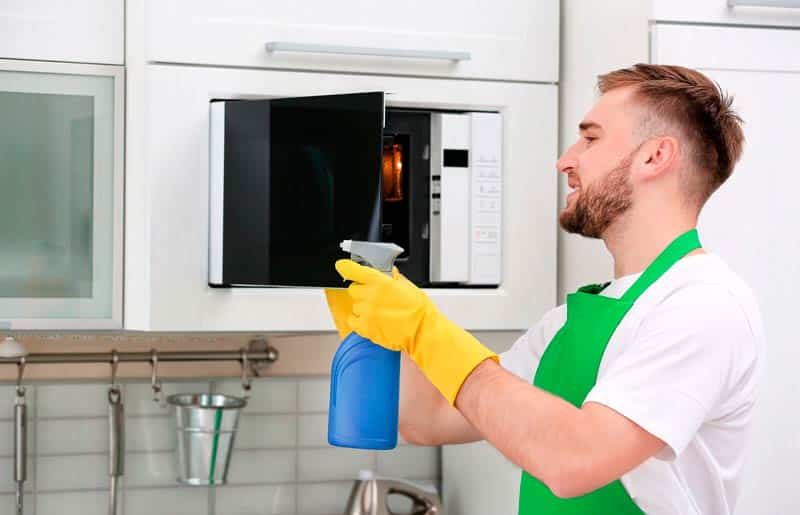We've independently reviewed this article to make sure it's as accurate as we can make it.
To find out more about our article creation and review process, check out our editorial guidelines.
Is there rust inside your microwave?
That sucks! I know how concerning it can be to open the microwave door and notice rust inside, especially when you’re unsure how to address it.
Don’t worry, though. You’ve come to the right place.
If your microwave is rusted inside, you’ll need to unplug the unit, clean the interior thoroughly, sand the rusted areas, and apply microwave-safe paint. Regular maintenance is essential to prevent rust from reappearing.
Read on to learn more about how to handle rust in your microwave!
Handling Rust In Your Microwave: 4 Simple Steps
In this section, I’ll walk you through the four steps you must follow to deal with rust in your microwave.
These are the materials you’ll need:
- Microwave-safe bowl.
- Warm water and vinegar or a commercial kitchen cleaner/degreaser.
- Soft sponge and cloth.
- Fine-grit sandpaper.
- Microwave-safe paint and newspaper.
- Paintbrush.
Are you ready to fix the issue? Let’s get started!
#1 Unplug Your Microwave
When I see a rusted microwave, I always unplug it from the power outlet.
Unplugging your microwave ensures no electrical power is flowing to the unit while you clean the interior or repair the rusted areas, preventing electrical hazards.
When you unplug the microwave, you’ll also prevent it from accidentally turning on while repairing the affected areas, which can lead to injuries.
Once you’ve unplugged your microwave, please make sure you have the manufacturer’s manual handy, as you’ll probably need to remove the turntable and other components to repair the rusted areas effectively.
Keep in mind that if you’re uncomfortable repairing the microwave yourself, there is absolutely no shame in consulting a professional. They have the tools and experience to ensure your microwave is repaired correctly.
However, if you’d still like to go the DIY route, please keep reading!
#2 Clean the Interior
Now that your microwave is unplugged, it’s time to clean the interior.
Sometimes, what appears to be rust is actually dirt or burnt food particles. So, cleaning your microwave not only prepares the rusted areas but also helps you distinguish between rust and dirt.
In my opinion, one of the easiest ways to clean a microwave is by mixing warm water and vinegar in a microwave-safe bowl. Then, place the bowl inside the unit and microwave it in the highest setting for 5 minutes.
Once the timer goes off, wait a couple of minutes to allow the steam to break down the grease and debris. Then, wipe the interior with a damp cloth or soft sponge and allow the microwave to dry. If needed, use a mild detergent to remove any stubborn residue.
Note: If you prefer using a commercial cleaner or degreaser, that’s perfectly fine! Just make sure it doesn’t contain harsh chemicals and read the product’s label.

It’s also important to wait for the interior to cool down and remove the turntable. Then, fill your sink with warm, soapy water and soak the turntable for a few minutes. Use a sponge to gently scrub the turntable and rinse it thoroughly.
After cleaning your microwave, please inspect the interior. Did the rust disappear, or is it still present? If your microwave still shows signs of rust, then try the next steps.
#3 Sand the Rusted Areas
When dealing with a rusty microwave, my usual advice is to sand the affected areas.
You see, sanding helps prevent further rust formation and prepares the surface for treatment. It also improves the appearance of the rusted area.
Here’s how to sand the rusted areas:
- Make sure your microwave’s interior is clean and dry.
- Get a fine-grit sandpaper to avoid damaging the metal surface of your microwave.
- Gently sand the rusted area until all visible rust is removed.
- Wipe the sanded area with a cloth. You can also use a vacuum cleaner to remove the remaining rust particles from your microwave.
Keep in mind that if the rust is too deep or has covered most of your microwave’s interior, it’s best to call a professional or consider replacing the microwave. Trying to sand away extensive rust can damage the microwave’s metal surface, leading to multiple performance issues.
#4 Apply Microwave-Safe Paint
To completely remove rust from your microwave, it’s time to apply a compatible paint.
It’s crucial to apply microwave-safe paint to the sanded area. Otherwise, the metal surface will be exposed to moisture and oxygen, leading to the reappearance of rust.
Applying microwave-safe paint is very simple; you’ll just need to:
- Cover surrounding areas, such as the interior light, with newspaper to protect them from drips or spills.
- Shake the paint well before applying it to the affected area.
- Use a small brush to apply a thin coat of paint to the area you’ve previously sanded. If you’re using a spray, please hold the can at the recommended distance and apply the paint using sweeping motions.
- Let the first coat dry completely, and apply a second coat if needed.
- Make sure that all exposed metal is fully covered.
- Leave the microwave door open to allow the paint to dry completely before using the unit again.
Please note that using a paint not specifically designed for microwaves can be risky. Most paints are flammable and not designed to withstand high temperatures. Additionally, regular paints can also release harmful chemicals when heated. To prioritize your safety, make sure the paint you choose is certified as microwave-safe.
FAQs About Rusty Microwaves
Whether you’ve found rust inside your microwave or want to learn how to prevent it, please keep reading. In this section, I’ll answer the most common questions about rust in microwaves.
Is It Safe to Use a Rusty Microwave?
While a small amount of rust inside your microwave is typically not a safety concern, it can lead to various issues over time. Therefore, it’s crucial to address any rust, regardless of the amount immediately.
You see, rust can cause sparks and lead to a fire hazard. If the rust has exposed the metal underneath, it could also interrupt the uniform reflection of microwaves, leading to uneven heating.
Why Do Some Microwaves Rust Inside?
Rust can form inside your microwave due to the exposure to moisture and humidity created during cooking, especially when the protective coating is damaged or worn.
I find that the easiest way to prevent rust is to wipe the microwave’s interior after each use, clean up spills immediately, cover your food, and make sure to clean the unit regularly. It’s also important to avoid using harsh chemicals.
What Is the Lifespan of a Microwave?
A well-maintained microwave can last up to ten years. However, the presence of rust can significantly impact the appliance’s lifespan.
If the interior is severely rusted, it’s likely best to consider getting a new microwave instead of repairing the affected areas.
Wrapping Up: Addressing and Preventing Microwave Rust
Hopefully, now you know how to handle rust in your microwave.
Remember that if your microwave is rusted inside, you’ll need to unplug it from its power source to prevent electrical hazards. Then, clean the interior with vinegar and warm water or a commercial cleaner. Don’t forget to sand the affected area and apply microwave-safe paint.
Thank you so much for taking the time to read this guide. If you’ve found it helpful, please check out our other related posts below.
Have a wonderful day!









